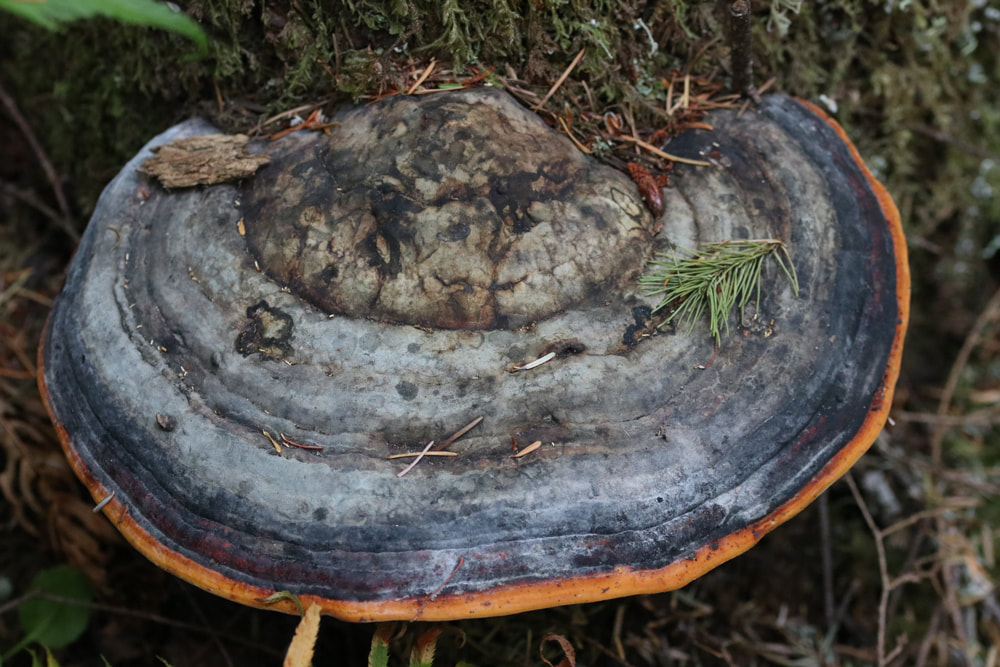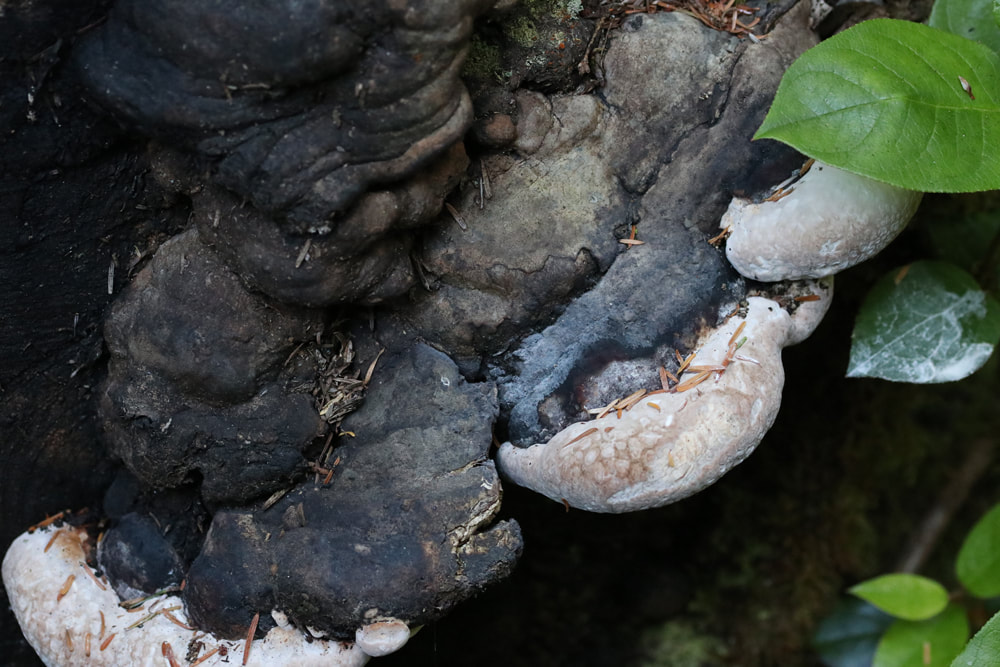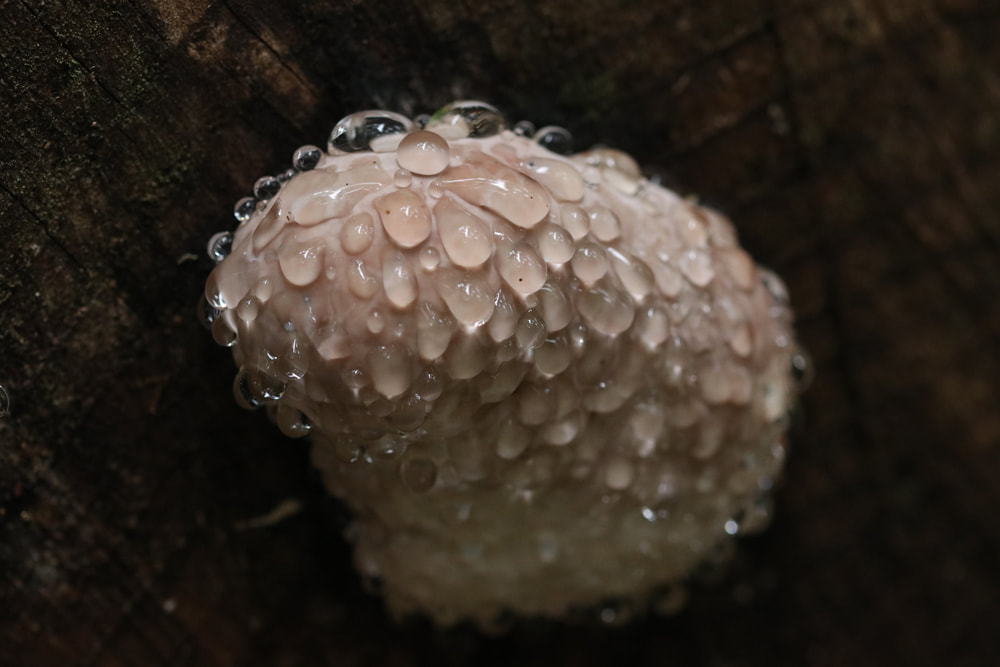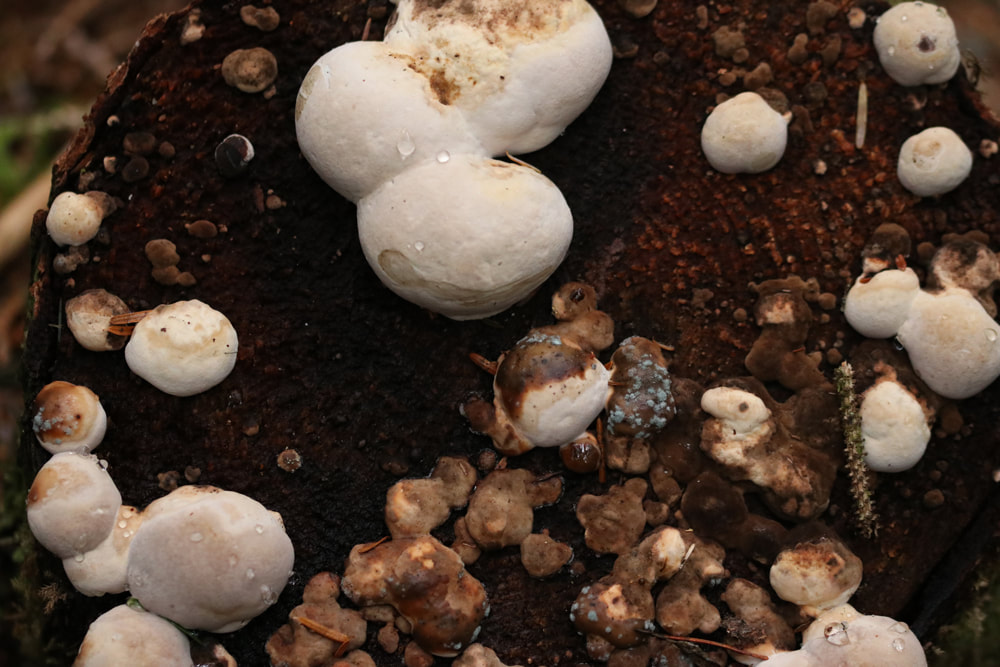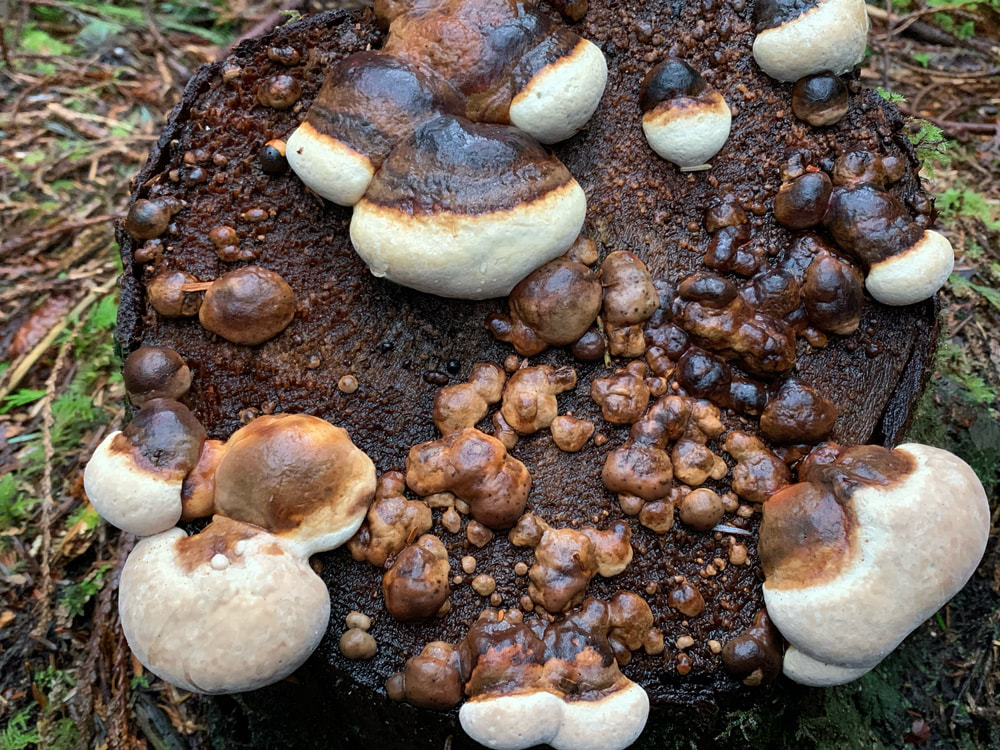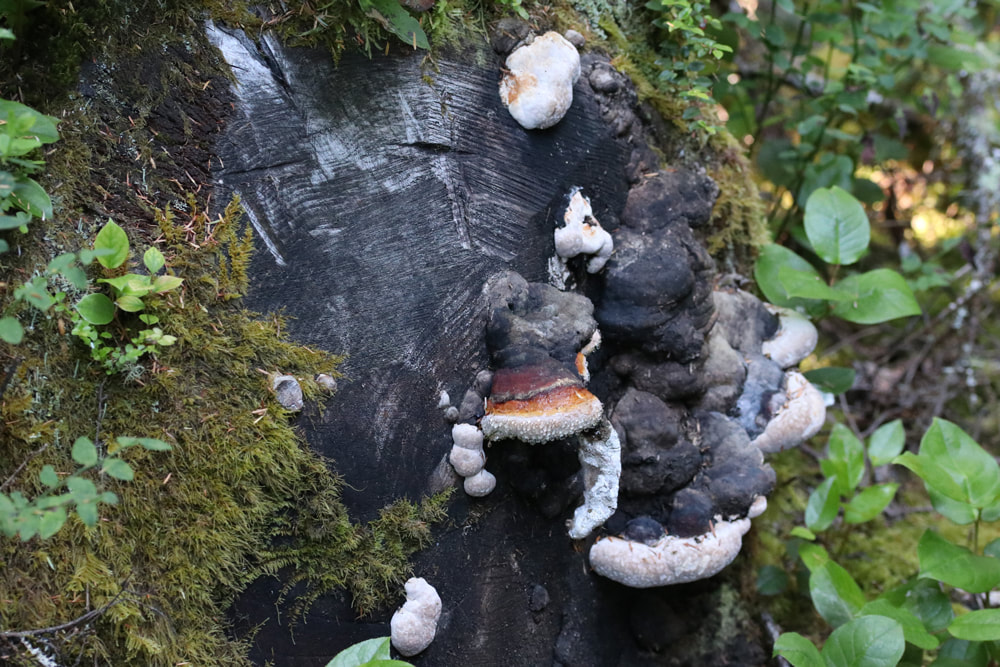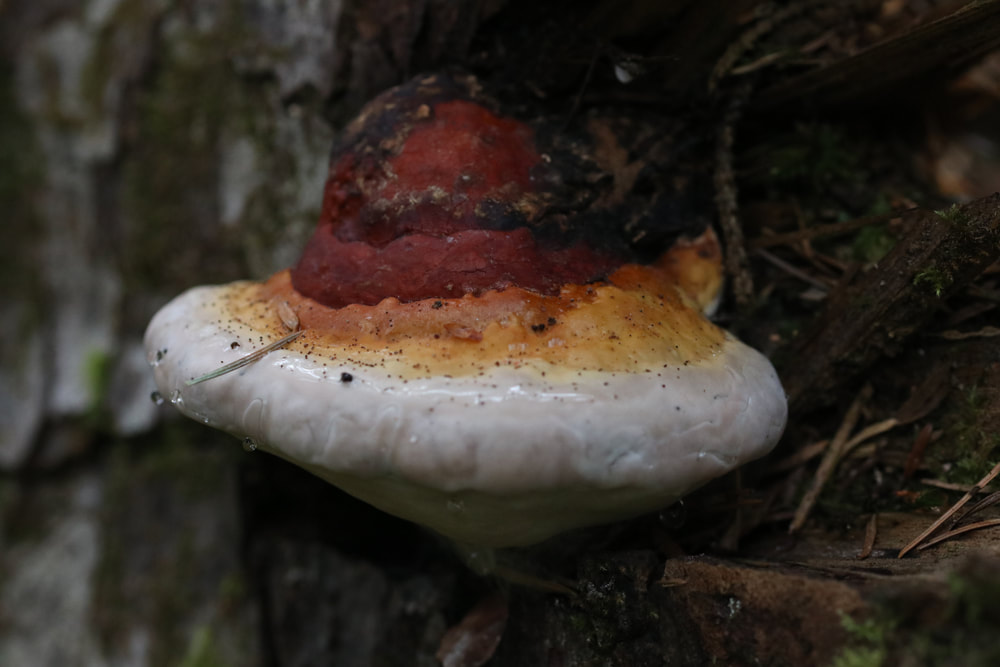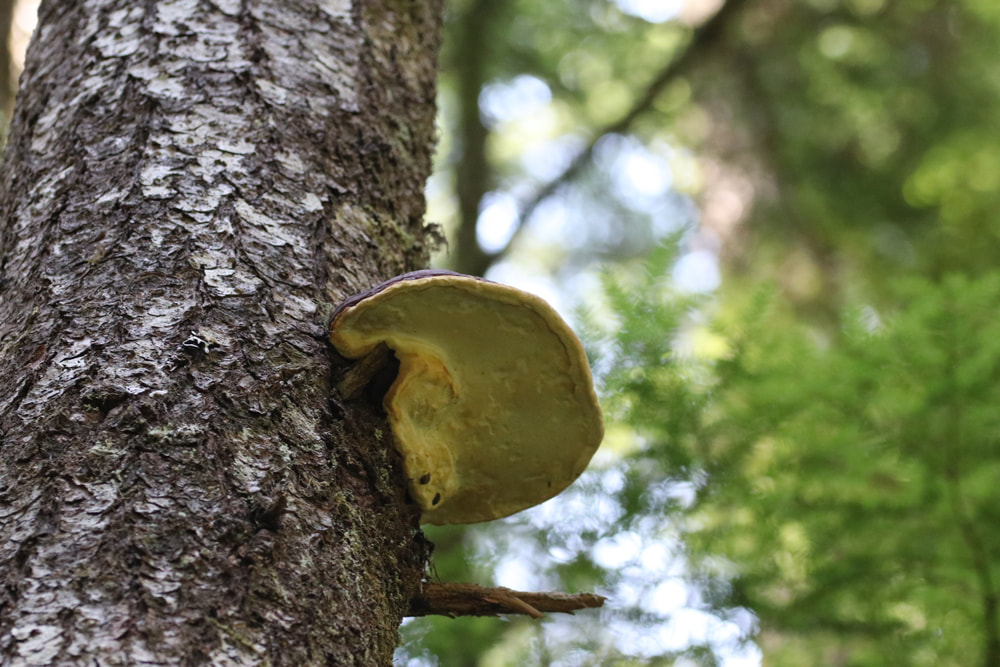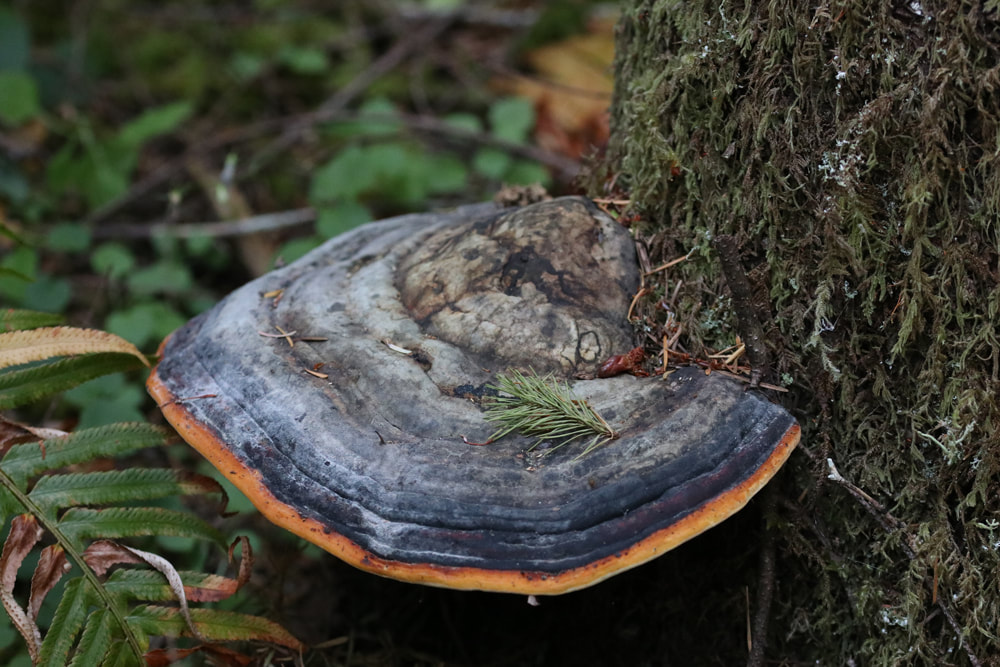Fomitopsis mounceae
Over the past year I have encountered the Fomitopsis mounceae in a variety of locations around Oregon. It has always been on tree stumps or stands and in darker parts of the forest. The beginnings of these forms look like little white marshmallows growing out of the log. As they get larger they forms become irregular and lumpy black and red. Sometimes they form a perfect hoof shape too. I have often found them weeping water after a rain storm. The droplets seem to stick to the pores surface like Velcro and I always wondered how many spores might be in those rain drops.
F. mounceae is a common conk and helps in the decomposition of wood into soil and causes brown rot in dead hardwoods and conifers. You can find this from Canada to Northern California and in the Appalachians to Tennessee and in Puerto Rico. F. mounceae is sympatric with Fomitopsis shrenkii, and looks (macro- and microscopically) the most similar to that as well. You will often see this conk referred to as Fomitopsis pinicola group but this has been proven to only occur in Eurasia and does not occur in North America. It is because of genetic sequencing and generations of scientists, naturalists and citizen scientists that we are able to study fungi in greater depths.
F. mounceae is a common conk and helps in the decomposition of wood into soil and causes brown rot in dead hardwoods and conifers. You can find this from Canada to Northern California and in the Appalachians to Tennessee and in Puerto Rico. F. mounceae is sympatric with Fomitopsis shrenkii, and looks (macro- and microscopically) the most similar to that as well. You will often see this conk referred to as Fomitopsis pinicola group but this has been proven to only occur in Eurasia and does not occur in North America. It is because of genetic sequencing and generations of scientists, naturalists and citizen scientists that we are able to study fungi in greater depths.
Fomitopsis mounceae
Classification:
Fungi
Dikarya
Basidiomycota
Agaricomycotina
Agaricomycetes
Polyporales
Fomitopsidaceae
Fomitopsis
Description:
Basidocarps perennial, woody, sessile; typically applanate about 180mm across X 80mm deep.
Pileus: glabrous, often sticky resinous coating, Usually has a shiny red or reddish brown band near the margin. In older specimens the plus is uneven with bumps at the base, the upper piles is black to brownish orange, the mid piles is grayish brown to reddish brown. Margin is rounded, smooth and white to an orangish color.
Pore surface: not receding or contracting, yellowish white to pale orange. Pores are curcular, and about 5 pores per mm.
Spore print: whiteish, spores cylindrical to ellipsoid, smooth and inamyloid. 3.5x6 um.
"Named for Irene Mounce (1894-1987), a pioneering Canadian mycologist, for her contributions to mycology and Fomitopsis" (Haight et. al., p344). Take a minute and learn about some women like Irene Mounce in Mycology here. Our Mycological mothers are so important to the work we see in our current literature today.
Classification:
Fungi
Dikarya
Basidiomycota
Agaricomycotina
Agaricomycetes
Polyporales
Fomitopsidaceae
Fomitopsis
Description:
Basidocarps perennial, woody, sessile; typically applanate about 180mm across X 80mm deep.
Pileus: glabrous, often sticky resinous coating, Usually has a shiny red or reddish brown band near the margin. In older specimens the plus is uneven with bumps at the base, the upper piles is black to brownish orange, the mid piles is grayish brown to reddish brown. Margin is rounded, smooth and white to an orangish color.
Pore surface: not receding or contracting, yellowish white to pale orange. Pores are curcular, and about 5 pores per mm.
Spore print: whiteish, spores cylindrical to ellipsoid, smooth and inamyloid. 3.5x6 um.
"Named for Irene Mounce (1894-1987), a pioneering Canadian mycologist, for her contributions to mycology and Fomitopsis" (Haight et. al., p344). Take a minute and learn about some women like Irene Mounce in Mycology here. Our Mycological mothers are so important to the work we see in our current literature today.
Resources:
Arora, David (1986). Mushrooms Demystified, 2nd ed.
https://www.bclocalnews.com/news/pioneering-scientists-remembered-on-eve-of-international-womens-day/
https://www.mycobank.org/page/Simple%20names%20search
Haight, John-Erich & Nakasone, Karen & Laursen, Gary & Redhead, Scott & Taylor, D. Lee & Glaeser, Jessie. (2019). Fomitopsis mounceae and F. schrenkii-two new species from North America in the F. pinicola complex. Mycologia. 111. 1-19. 10.1080/00275514.2018.1564449. https://www.researchgate.net/publication/331996246_Fomitopsis_mounceae_and_F_schrenkii-two_new_species_from_North_America_in_the_F_pinicola_complex
Siegel, Noah and Christian Schwarz (2016). Mushrooms of the Redwood Coast: A Comprehensive Guide to Fungi of Coastal Northern California
Trudell, Steve & Joe Ammirati (2009). Mushrooms of the Pacific Northwest
Arora, David (1986). Mushrooms Demystified, 2nd ed.
https://www.bclocalnews.com/news/pioneering-scientists-remembered-on-eve-of-international-womens-day/
https://www.mycobank.org/page/Simple%20names%20search
Haight, John-Erich & Nakasone, Karen & Laursen, Gary & Redhead, Scott & Taylor, D. Lee & Glaeser, Jessie. (2019). Fomitopsis mounceae and F. schrenkii-two new species from North America in the F. pinicola complex. Mycologia. 111. 1-19. 10.1080/00275514.2018.1564449. https://www.researchgate.net/publication/331996246_Fomitopsis_mounceae_and_F_schrenkii-two_new_species_from_North_America_in_the_F_pinicola_complex
Siegel, Noah and Christian Schwarz (2016). Mushrooms of the Redwood Coast: A Comprehensive Guide to Fungi of Coastal Northern California
Trudell, Steve & Joe Ammirati (2009). Mushrooms of the Pacific Northwest

